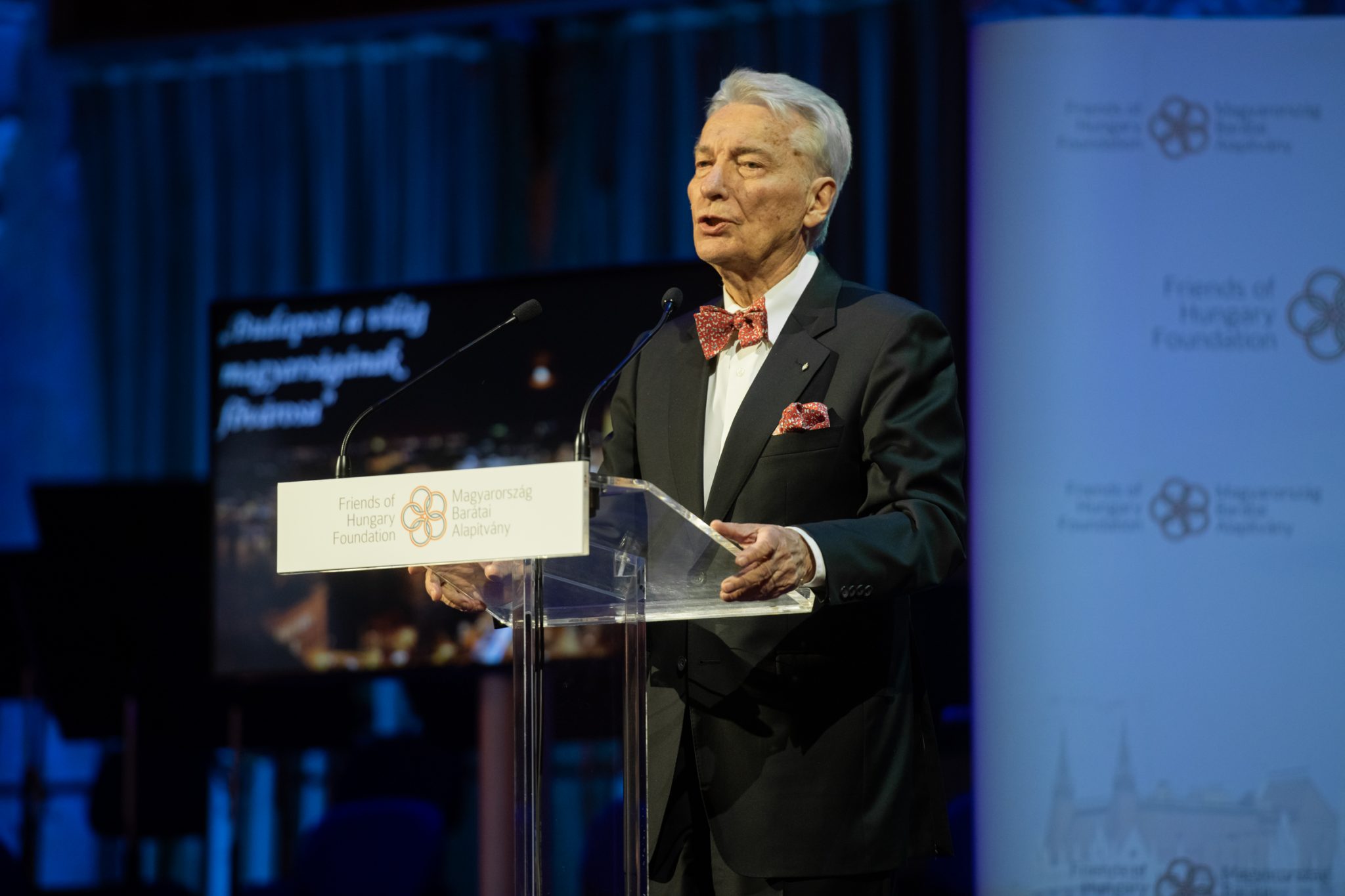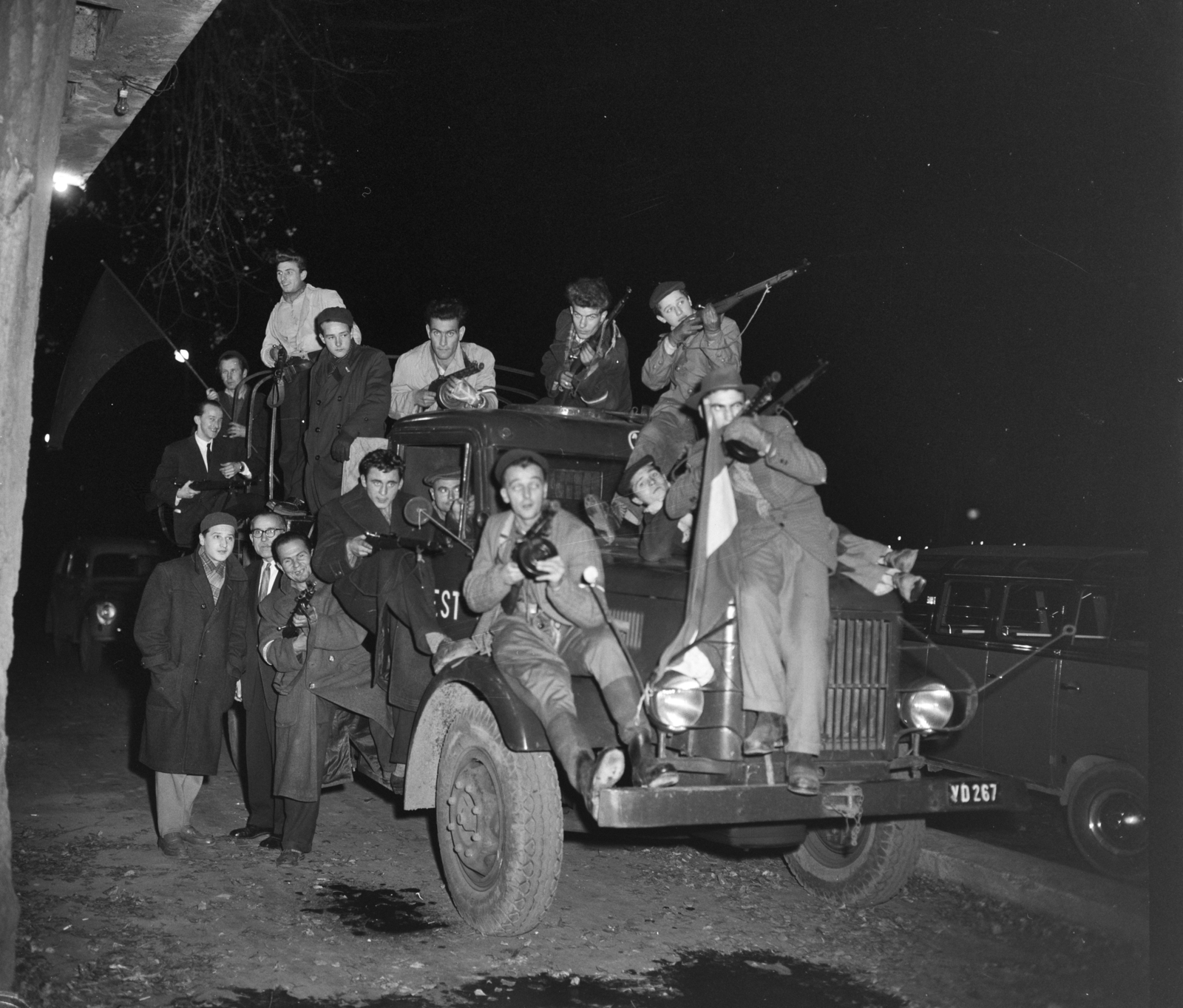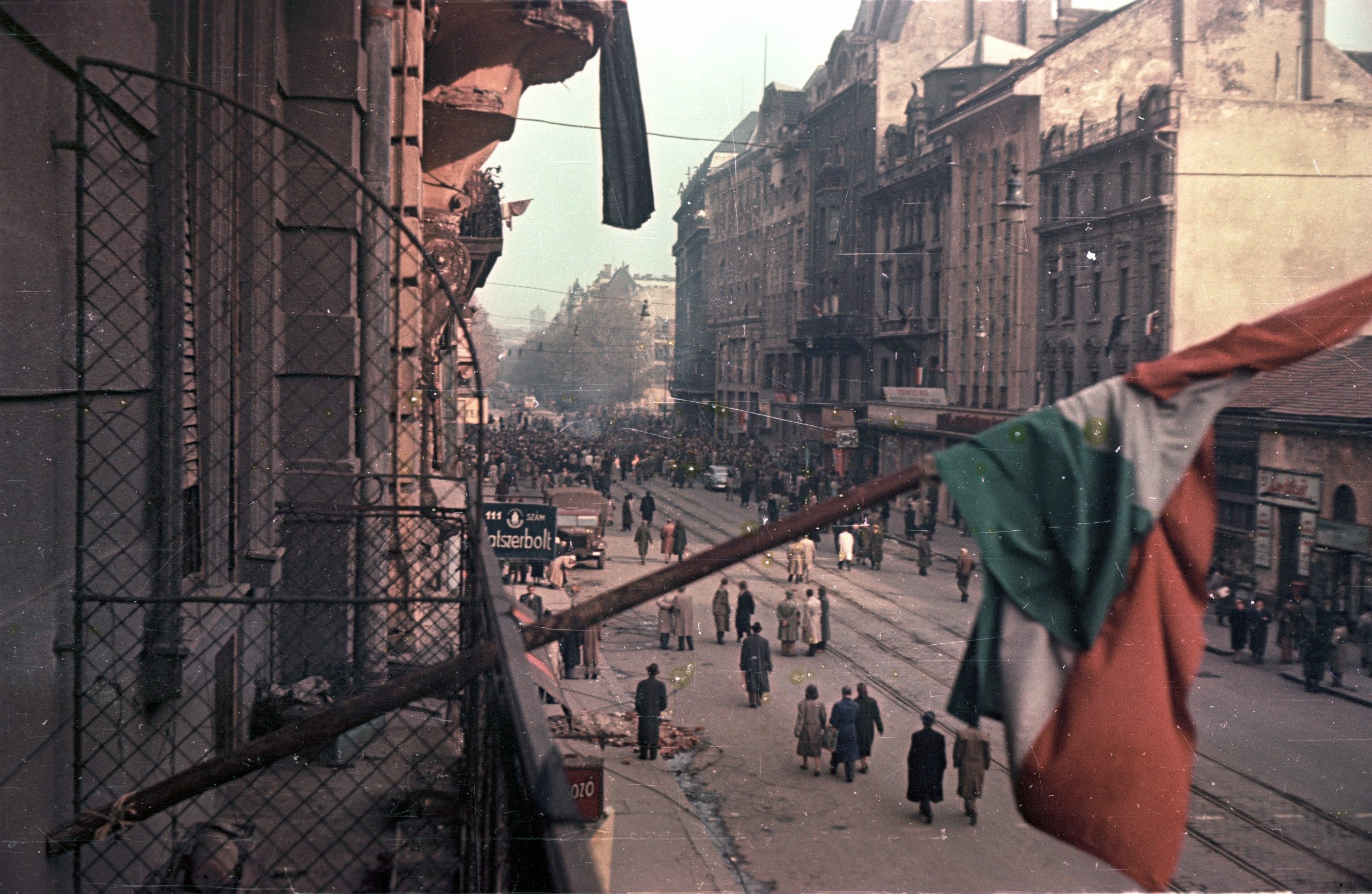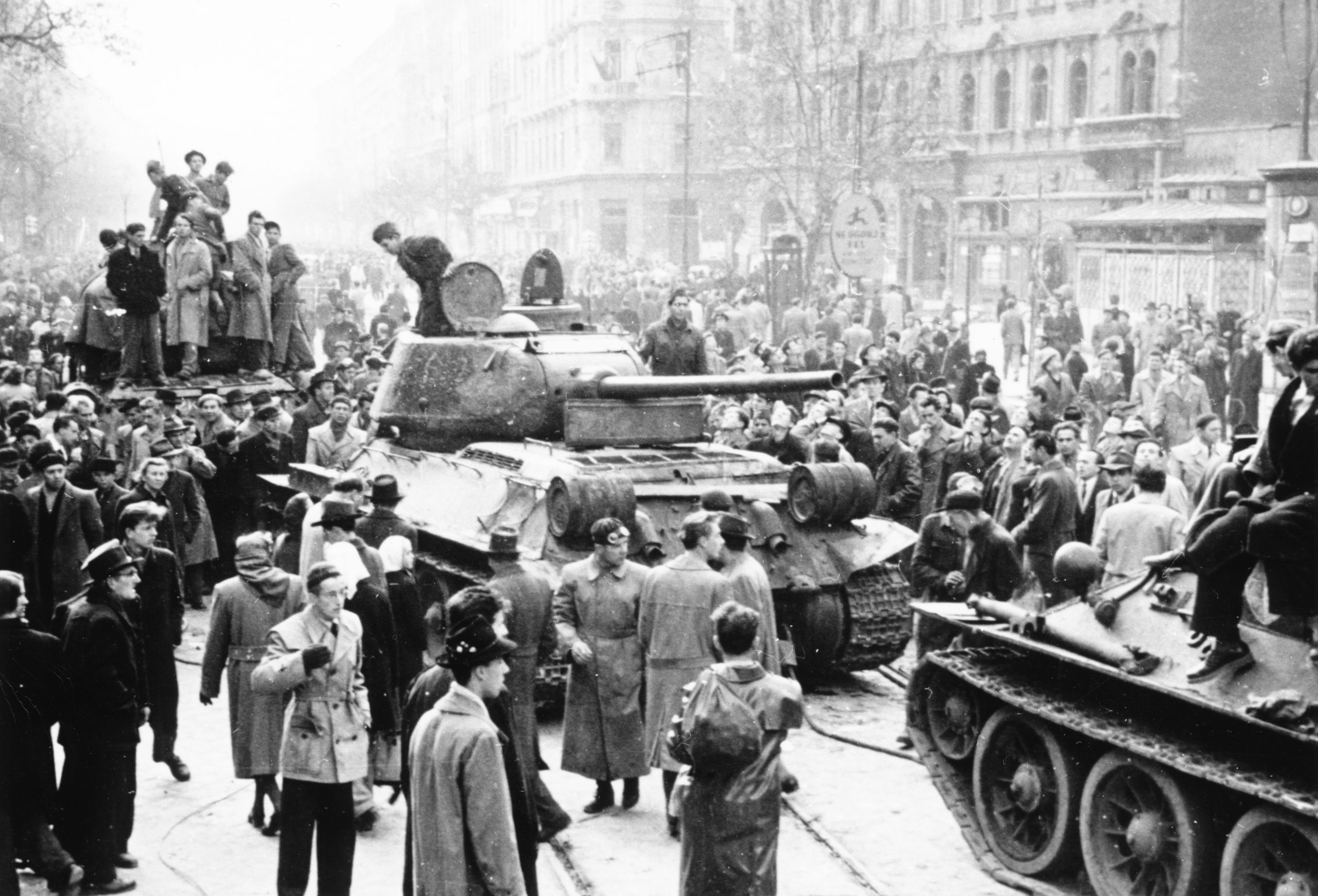
“All historical deeds motivated by the pursuit of freedom and justice become universal after a while, just like scientific efforts for the benefit of humanity,” emphasized Professor E. Sylvester Vizi, former President of the Hungarian Academy of Sciences, in his commemorative letter to the Hungarian Revolution of 1956. The Chair of the Friends of Hungary Foundation, publisher of our portal, added: “the Hungarian people have proved their love of freedom several times in their thousand-year history, but this was unprecedented during the 1956 Revolution, when Hungary ‘as a small country, but as a great nation’ opposed the Soviet empire.”
This article was originally posted on our sister-site, Ungarn Heute.
“Stubborn Hungarian revolutionary forces are continuing to fight the Soviet army in Budapest, according to diplomatic reports received in Vienna. Women and children were said to be fighting alongside the men in a house-to-house struggle…”, read the front page of the New York Times on November 7, 1956. And although the Hungarian Revolution had already ended by the time of the New York Times report quoted above, “the heroic sacrifices of the insurgents have set an example for generations to follow,” begins E. Sylvester Vizi’s recollection of the ’56 events.
The professor emphasizes in his letter that “the Hungarian Revolution of October 23, 1956, was perhaps the most European moment in our recent history: its spirit of a European wish for freedom has proved that it will never die out.”
Vizi quotes the world-famous French writer, Francois Mauriac, winner of the Nobel Prize for Literature, who said the following about the bravery of Hungarians:
When the stronger side is systematically inhumane, then perhaps the course of history is set by the will of the weaker.”
And it is indeed true, says Vizi, that the students of Szeged, Pécs, and Pest were brave enough to fight against the greatest power in the world because of the inhuman nature of Soviet-type totalitarianism. “Moreover, they sacrificed their lives for the enduring European spirit of freedom,” adds the professor.
Related article
Faces of the 1956 Revolution - with Archived Photos!
There are a couple of 1956 freedom fighters and groups of fighters who became well-known, either by their acts, their martyr deaths, or by archived photographs appearing in international newspapers or domestic publications. Some were even painted on firewalls of the capital. The Széna square group of freedom fighters and the Pest lads are all […]Continue reading
(Vizi became a member of the “Battalion of the National Guard” of the University in Pécs in 1956, led by a fifth-year student. They collected food in Pécs and the surrounding villages for those fighting in Budapest and transported it to the capital under armed escort).
The Hungarian struggle for freedom had been crushed by the Red Army in a sea of blood. The many thousands of deaths of the Hungarian Revolution and the people condemned to death and executed after the Revolution was the moral Stalingrad of world Bolshevism,”
said Vizi.
Furthermore, he quotes the Russian poet and writer, Boris Pasternak, (internationally known mainly for his novel Doctor Zhivago. In 1958 he was awarded the Nobel Prize for Literature, which he could not accept for political reasons. – Editor). Learning about the systematic cruelty committed against Hungarian freedom fighters, Boris Pasternak sent a postcard to Budapest to his Hungarian friend Gyula Illyés, author of the dramatic poem entitled “A Sentence on Tyranny.” The Russian wrote to Illyés:
“… I am saddened and shocked by the resurgence of inhuman atrocities which we thought had all gone with the past… How humiliating that this omnipotence of evil cannot be restricted by the good!”
Not only Pasternak but European intellectuals at large were also shocked to learn what had happened in Hungary, Vizi points out, adding that later the European era of Communism ended because the overwhelming majority of European intellectuals had lost faith in it.
That was the time when Albert Camus wrote in his essay, “The Blood of the Hungarians:” “It’s hard for us to be worthy of so much sacrifice. Yet we must try. Let us forget our disputes, reconsider our mistakes, multiply our efforts and solidarity in a Europe that will ultimately unite.”
Related article
The 1956 Uprising in Color - Photo Gallery!
On the 23rd of October in 1956, Hungarian students and young workers staged a peaceful demonstration in Budapest to protest against the ruthless Communist dictatorship forced onto the country by the Soviet Union at the end of the Second World War. The protesters drew up a list of sixteen demands aimed at changing the hopeless […]Continue reading
Then the professor makes a leap in time to the Prague Spring of 1968 as well as to the Pan-European Picnic, when “after dramatic days the Hungarian border was opened for Germans from the then GDR,” and the Berlin Wall fell. Germany was reunified and Hungary became a member of NATO and the European Union. Nobody believed that the wheel of history could be turned forward so easily and that Francois Mauriac would be right: “All historical deeds motivated by the pursuit of freedom and justice become universal after a while, just as scientific efforts on behalf of humanity gradually become international goods.”
According to Vizi, “the Hungarian revolutions have a peculiar fate,” since the deathly silence after 1848-49 was followed by the Compromise and a rich, prosperous era, even if many among them, including Kossuth, could not reconcile themselves with what had happened. (Lajos Kossuth was a politician and one of the leaders of the Hungarian Independence Uprising against the Habsburgs in 1848-49. Even after the suppression of the revolution, he continued to advocate for Hungary’s independence from the Habsburg Empire while in exile until his death. To this day, Kossuth is considered a Hungarian national hero – Editor).
As for the period after the suppression of the 1956 revolution, the professor believes that the 1970s/80s also saw the development of a consolidated era, so to speak, in Hungary. However, according to Vizi, these were not “happy years of peace” as at the end of the 19th century, “because all the physical and mental sufferings of the stifled revolution were present in the ’60s, ’70s, and ’80s.”
During the Kádár regime, more than 200,000 of our compatriots fled the country and left their homes. In addition, the lives of many were embittered by the fact that more than 3,000 people fell victim to the fighting, and 229 martyrs were executed during the reprisals. In addition, more than 4,500 people were locked in prison, many were deported without an official trial, mentally and physically ruined.
Hard to believe, but the number of retributions in Hungary after 1956 was much greater than the number of executions in Germany after World War II.
Vizi goes on to say that the years after 1957 were also marked by a wave of retributions: many martyrs were sentenced to death on the gallows and buried in unmarked graves, while thousands more languished in prisons for many years. The martyrdom of Imre Nagy also belonged to this period.
Fact
Three days after Hungary’s Prime Minister Imre Nagy proclaimed the country’s neutrality and revoked his country’s membership in the Warsaw Pact on November 1, 1956, Soviet tanks entered Hungary and bloodily crushed the revolution. Premier Nagy had to flee to the Yugoslav embassy. Later, the new head of the government, János Kádár, promised him immunity from prosecution, but he was arrested by the KGB and deported to Romania and placed in solitary confinement. It was not until a year and a half later that he was convicted in a secret trial.
According to E. Sylvester Vizi, the country “paid a very high price” for the relative calm, for the freedom that came with the regime change, and for the respect of the world. “This can also be illustrated by U.S. President John F. Kennedy’s speech at the commemoration on October 23, 1960:”
“October 23, 1956, is a day that will forever live in the annals of Free Men and Free Nations. It was a day of courage, conscience, and triumph. No other day since history began has shown more clearly the eternal unreachability of man’s desire to be free, whatever the odds against success, whatever the sacrifice required.”
Related article
Why did Beethoven's Egmont Overture Become the “Hymn of the Revolution”?
The powerful melody of Beethoven intertwined with the events of the revolution, from the night at the Parliament, to the siege of the radio building and to the point when Imre Nagy announced at noon on October 24 that those who would immediately lay down their weapons would receive amnesty.Continue reading
The professor also commemorates the “boys of Budapest,” who “risked their young lives in courageous self-sacrifice. But, equally, we must remember all those condemned to death by a summary court, many of whom were young working lads. What bitter irony is involved here: they had all fought for their fellow workers, and it was an alleged ‘workers rule’ that took their lives in reprisal.”
As for today’s situation of a united Europe, at that time, a Europe under one common roof was still a dream, but today it is a reality.
We are in the EU, we are free and now everything depends on us,”
says the professor, who at the same time also emphasizes that as a doctor, brain researcher, and as the Chair of the Friends of Hungary Foundation, he believes that “everything in life depends on the mindset and mentality of people.” Precisely for this reason, he considers it “inevitable” that people will remember their past.
“Why does one have to remember?”, Vizi asks, and also answers it himself: “To be able to learn from the past. ‘Sine preteritis nulla futura’ is a Latin phrase. That means, without the past, there is no future. And today we will remember. We remember the past. We must never forget that freedom was defined by the bloodshed on the streets of Budapest.”
Finally, the professor emphasizes in his letter that the Hungarian people have proven their love of freedom several times in their thousand-year history, but it was unprecedented in 1956 when they opposed the Soviet empire “as a small country, but as a great nation.” “No one can deny us the truth of this statement. Hungary deserves justice!” E. Sylvester Vizi concluded his thoughts.
Featured photo by Hungary Today



